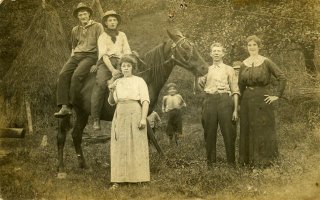 Of course the young people in this photo are definitly not dressed for making hay, but the photo shows the haystacks in the background. From the time of the first settlers in the early 1800s until the 1960s or so these hay stacks would appear in late summer, dotting flat or gently sloping fields along the creeks and runs. Making hay was one of the many, many tasks of farm life.
Of course the young people in this photo are definitly not dressed for making hay, but the photo shows the haystacks in the background. From the time of the first settlers in the early 1800s until the 1960s or so these hay stacks would appear in late summer, dotting flat or gently sloping fields along the creeks and runs. Making hay was one of the many, many tasks of farm life.Diane (Hill) Zimmerman (who is not from Orlando)1 wrote the following about making hay. "I often helped make hay because I loved horses and was very good with them. No one I knew had a tractor. Sometimes I was paid as much as a quarter a day. After cutting the hay was raked into rows, then forked into little stacks. My job was to position the horse so that a long pole could be driven under the stack which was tied down with
 a loop of rope. I then road to the big stack where this hay would be pitched. Making a good, stable haystack was quite an art."
a loop of rope. I then road to the big stack where this hay would be pitched. Making a good, stable haystack was quite an art."In the 1960s and '70s Hay making began to be mechanised and rectangular hay bales began to replace the haystacks. Now, of course, we see great round cylinders of hay, sitting on their sides.
Judging from the background, this photo above, left, was taken in the late summer. The young people in it all lived across Oil Creek from the where the brick St. Michael Roman Catholic church would be built. (Today it is a Baptist Church.) Sitting on the horse are Polar and Pid Henline. To the right of the horse are Heaterhuck Henline and Vada Riffle who would one day marry Polar. In the foreground is Margaret (Henline) Nixon. Polar was born in 1892 and appears to be about 16 here, so the photo was probably taken before 1910.
To the right, Marion Furman Wymer makes hay on Oil Creek.
1. Lewis County, West Virginia: Her People and Places ed. JoyGilchrist Stalnacker. Published by Walsworth Pub.Co. for Hackers Creek Pioneer Descendants. pg. 14.
The author never lived in the Orlando area; she grew up 50 miles or so north of Orlando in Harrison County in the 1940s. I wouldn't think making hay was any different there than in the Oil Creek area. If you know, please let us know.



No comments:
Post a Comment